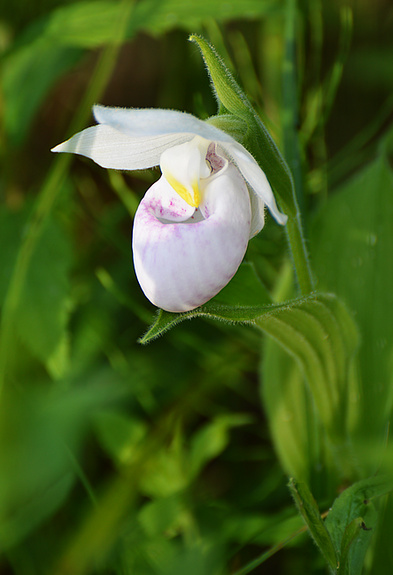
A Price Worth Paying (part 2 of 3)
July 21st, 2017
(Part 1, Part 3)
I tallied four separate singing Northern Waterthrushes over the course of my hike, the most I've ever heard in one day. (Saw none of them. Par for the course with Northern Waterthrushes.) And indeed, what I could see through the trees looked like waterthrush paradise, for much the same reason it was mosquito paradise: abundant, pristine standing water and gently flowing water. Somewhere in there, a little streaky brown bird was walking along the water's edge, tail bobbing, searching for aquatic insects and crustaceans or maybe even wading into the water to snap up minnows. But I could only imagine it, not see it.
After awhile I came to a spot where swampy woods gave way to a large, open wetland. It appeared a grassy marsh at first glance, but the presence of what looked like bog cotton suggested otherwise. These are the snowy-white tufts that blanket Mer Bleue bog in late spring and summer, giving the landscape a strange, almost alien beauty. They did not blanket this place, but that there were any of them was very suggestive. This was no mere marsh, and there might be things to see that I don't see often.

Bog Cotton?

It was on the margin of this wetland that I found my first in-bloom Showy Ladyslipper.

Showy Ladyslippers are somewhat variable wildflowers. They can grow up to two feet tall and may have striking, deep pink highlights on the white slippers. This one was on the small and pale side, but beautiful nonetheless. I was thrilled to find it. I searched for more, but it was the only one I could see. Its presence suggested that the wetland was in fact a fen (neutral-to-alkaline and fed by groundwater), which in turn suggested that the "Bog Cotton" was actually its relative, Slender Cottongrass. (I'm rather out of my depth here. I'd love to take a field botanist along with me on this hike!)

These little beauties also grew on the margins of the wetland. The very dark, purplish lateral petals mark them, I think, as a variation known as Small Yellow Lady's Slipper (Cypripedium parviflorum var. makasin). Compared to the larger and more common variety, these are about half the size and prefer wetter habitat, particularly fens and bogs.
July 21st, 2017
(Part 1, Part 3)
I tallied four separate singing Northern Waterthrushes over the course of my hike, the most I've ever heard in one day. (Saw none of them. Par for the course with Northern Waterthrushes.) And indeed, what I could see through the trees looked like waterthrush paradise, for much the same reason it was mosquito paradise: abundant, pristine standing water and gently flowing water. Somewhere in there, a little streaky brown bird was walking along the water's edge, tail bobbing, searching for aquatic insects and crustaceans or maybe even wading into the water to snap up minnows. But I could only imagine it, not see it.
After awhile I came to a spot where swampy woods gave way to a large, open wetland. It appeared a grassy marsh at first glance, but the presence of what looked like bog cotton suggested otherwise. These are the snowy-white tufts that blanket Mer Bleue bog in late spring and summer, giving the landscape a strange, almost alien beauty. They did not blanket this place, but that there were any of them was very suggestive. This was no mere marsh, and there might be things to see that I don't see often.

Bog Cotton?

It was on the margin of this wetland that I found my first in-bloom Showy Ladyslipper.

Showy Ladyslippers are somewhat variable wildflowers. They can grow up to two feet tall and may have striking, deep pink highlights on the white slippers. This one was on the small and pale side, but beautiful nonetheless. I was thrilled to find it. I searched for more, but it was the only one I could see. Its presence suggested that the wetland was in fact a fen (neutral-to-alkaline and fed by groundwater), which in turn suggested that the "Bog Cotton" was actually its relative, Slender Cottongrass. (I'm rather out of my depth here. I'd love to take a field botanist along with me on this hike!)

These little beauties also grew on the margins of the wetland. The very dark, purplish lateral petals mark them, I think, as a variation known as Small Yellow Lady's Slipper (Cypripedium parviflorum var. makasin). Compared to the larger and more common variety, these are about half the size and prefer wetter habitat, particularly fens and bogs.
| ← | → |

Mike
July 24th, 2017 at 8:10 am
Ah, wildflower ID... how hard can it be, the plant doesn't exactly fly away, and you can get as close as you like!
Love the varieties of Lady's Slippers!